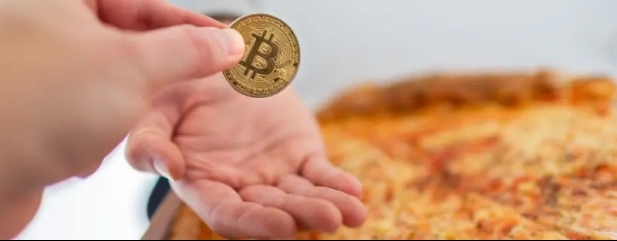Archived article
Please note that tax, investment, pension and ISA rules can change and the information and any views contained in this article may now be inaccurate.
What two pizzas ordered more than a decade ago tell us about Bitcoin

Spare a thought for Laszlo Hanyecz. You may not have heard of him, but in 2010 he spent 10,000 Bitcoins on two pizzas, in one of the first ever ‘real world’ crypto transactions. The market value of those Bitcoins is now $950 million. Hanyecz is pretty stoic about it, but deep down he must know that no amount of melted cheese can make up for the vast fortune he might have had. Hanyecz, a computer programmer from Florida, reckons he actually spent in total around 100,000 Bitcoins over the course of 2010 on pizza, which would currently have a value of £9.5 billion. He is now part of the foundation myth of Bitcoin, and his lunch bill from 14 years ago still prompts a sharp inhale of breath normally reserved for three-star Michelin eateries.
Hanyecz’s story first and foremost tells us about what a rocket-fuelled price escalator Bitcoin has been bounding up. When he bought his two pizzas with 10,000 coins, each coin was worth around $0.004. The cryptocurrency is now trading at $95,000 per coin. There have been a number of way stations along this breakneck journey, if you haven’t blinked at the wrong moment. It may be convenient for the crypto industry to gloss over it, but much of Bitcoin’s early usage came down to drug dealing.
The Silk Road was an early website on the darknet, a bit like eBay, but for illicit drugs and murder for hire. In 2020 US law officials seized $1 billion in Bitcoin as part of its investigation into the digital marketplace. Criminality has never been far from Bitcoin’s story. The anonymity it can provide still makes it ideal for darknet transactions, and crypto more generally has been a hotbed of scam activity and fraud. The nadir (so far) has probably been the FTX scandal, in which the crypto exchange’s founder, Sam Bankman-Fried, was sentenced to 25 years in jail for stealing $8 billion from customers.
PROSPERING DESPITE MURKY BEGINNINGS
And yet, Bitcoin has prospered. The arrival of crypto exchanges and platforms opened up trading beyond the tech bros who know what to do with a command prompt. More recently institutions have started to get in on the act, with the likes of Tesla (TSLA:NASDAQ) and MicroStrategy (MSTR:NASDAQ) holding Bitcoin on their balance sheets. Earlier this year, the US financial regulator approved Bitcoin ETPs (exchange-traded products); essentially Bitcoin tracker funds. This was a hugely significant step for the cryptocurrency, opening up the market even further to retail and professional investors alike, and providing a regulatory halo around the asset class.
This may just be the beginning, seeing as the next president of the US wants to make the country ‘the crypto capital of the planet’. Other competitors in this event include El Salvador, which has legalised Bitcoin as legal tender and announced plans to construct a Bitcoin city in the shape of a giant coin.
All of this has of course contributed to the rapid price ascent of Bitcoin, against a backdrop of increasing global digitalisation and the manipulation of major currencies through quantitative easing, which added fuel to the Bitcoin fire. Such extreme price appreciation is itself a cause for concern as previous buyers of tulips (17th century), South Sea companies (18th century), railroad stocks (19th century) or technology stocks (20th century) will attest. But Laszlo Hanyecz’s story doesn’t begin and end with the price explosion of Bitcoin. It also prompts us to ask, why didn’t he hold onto his Bitcoin holdings to become a multi-billionaire today?
HARD TO PREDICT THE TRAJECTORY
It’s clear from his pizza-buying spree, that even as an early adopter of Bitcoin, Hanyecz had no idea where the cryptocurrency was headed. With the price of Bitcoin closing in on $100,000, that remains the case today.
It might be helpful to think about Bitcoin in terms of three groups of potential users: investors, businesses, and consumers. Bitcoin does seem to be stepping more into the mainstream of the investment world. The launch of Bitcoin ETPs in the US is undoubtedly a meaningful event, because it makes it super easy for investors to buy Bitcoin in their normal trading accounts, provided by highly regulated brokers. These tracker funds aren’t available in the UK yet, but it wouldn’t be a surprise if they were in due course.
Meanwhile the first UK pension scheme has reportedly invested in Bitcoin, and back in 2020, the conservative asset manager Ruffer bought a slice. But, overall, there hasn’t been a groundswell of professional investors running diversified portfolios trying to get in on the cryptoverse. There is a high degree of scepticism around Bitcoin, and for professional money managers, its extreme price volatility will undoubtedly lead to both joyous and uncomfortable meetings with clients.
Consumers and businesses likewise haven’t on the whole embraced Bitcoin instead of pounds, dollars and euros. This again brings us back to the two pizzas bought by Hanyecz. Who exactly did he buy them from? The answer is a 19-year-old student called Jeremy Sturdivant, who responded to Hanyecz’s request for pizza on a Bitcoin chat room. Sturdivant, in turn, bought the pizzas from Papa John’s… using dollars.
And then to add insult to injury, converted the Bitcoin he received back into dollars to pay for travelling expenses. So rather than being the first real world crypto transaction, this encounter could equally be characterised as two computer geeks transacting in crypto, while the outside world trundled on oblivious, using its conventional forms of currency.
NOT IN MAINSTREAM USE YET
While there are more outlets which accept Bitcoin today, including Subway which is experimenting with the cryptocurrency, the vast majority do not. And why would they? Consumers can already buy products by flashing their mobile phone at a payment terminal using conventional currencies. Even those which accept Bitcoin almost certainly convert it into conventional currencies immediately. Subway won’t pay its staff in crypto, or its suppliers, so by holding something as volatile as Bitcoin, it could quickly find itself out of pocket if it didn’t convert it back into ‘real’ money immediately.
Consumers face the same issue. Their bills and expenditure are in pounds, euros, dollars, yuan, yen or rupees. Holding large sums of spending money in Bitcoin might well leave consumers unable to buy the M&S Christmas turkey they have their eye on, or even some essential winter underclothes in ‘Primani’.
Over time, more businesses, consumers, and investors may embrace Bitcoin. But it’s by no means certain, and there are plenty of obstacles, not least the potential launch of central bank digital currencies which may usurp many of the functions crypto prides itself on. It goes without saying that if you are buying crypto, do so with a small amount of money which you are able to lose without it having a dramatic effect on your overall wealth. And for goodness sakes, if you’re buying a takeaway this weekend, make sure you don’t pay too much for it.
Important information:
These articles are provided by Shares magazine which is published by AJ Bell Media, a part of AJ Bell. Shares is not written by AJ Bell.
Shares is provided for your general information and use and is not a personal recommendation to invest. It is not intended to be relied upon by you in making or not making any investment decisions. The investments referred to in these articles will not be suitable for all investors. If in doubt please seek appropriate independent financial advice.
Investors acting on the information in these articles do so at their own risk and AJ Bell Media and its staff do not accept liability for losses suffered by investors as a result of their investment decisions.
 magazine
magazine








